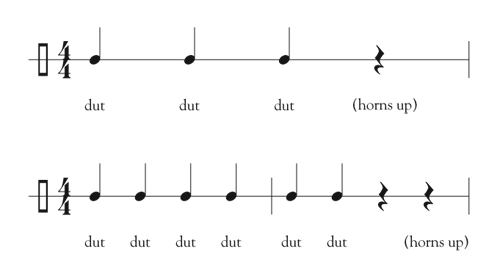It can be difficult for students to start and stop together. Here are some tips to keep everyone together on entrances and releases.
Entrances
When an ensemble is having difficulty with some entrances I keep the conducting plane flat so students have a sure focal point; this should make them confident of where the beat is going to be.
I also have students clap the rhythm of that entrance while I’m conducting. It is easy to hear if somebody is clapping in the wrong place than it is to hear one wind player out of many come in too soon. Getting off of the instruments and clapping can help students hear and feel exactly when they are supposed to enter. Usually only one or two students are early or late, and they are more likely to notice this themselves when clapping.
Another tactic, which I borrowed from drum corps, is having a snare drum play beats to give the group a reference. If students struggle with this, I back it up another measure, with six beats of snare drum followed by a rest and a horns up. This need not be as strict in concert band as it would be in a drum corps; the aim is for students to feel the beat and move on it. In an extremely slow tempo, it might be best to have the snare drummer subdivide the pulse.

The kinesthetic aspect of it seems help some stragglers, especially with younger groups. The students in Japanese school bands move as much as some professional players, and there seems to be some connection there. If moving works for elementary students who can play Holst, I am willing to give it a shot.
Releases
Releases can extremely difficult. Any time I can explain something in a way that is visual or physical for students, it seems to get the idea across easily. I sometimes have band students emulate bowing on releases. For soft releases I have them stop as if they were releasing by lifting the bow gently off the string. For more abrupt cutoffs I have students picture stopping the bow short on the string without lifting it at all. On slow passages, a good way to introduce some movement is to have students bob their instruments at the end of held notes, similar to what the leader of a chamber group might do.
I also sometimes get away from what standard circular cutoffs. Instead, I give more of a straight lift off of the conducting plane. This looks and feels similar to giving a downbeat, which seems to be clearer than other options. I use it more often with less experienced groups, especially if they have difficulty with releases in slower passages, or where there is a fermata at the end.
A standard circular cutoff motion is an excellent visual cue in some circumstances. When an orchestra releases, the low strings are the last sound heard because of the resonance of these instruments. To reproduce this, which I especially like to do when my band plays an orchestral transcription, I have students watch the circle of my cutoff and think of it as a clock. When we are holding a note, whether a long note or a fermata, during the hold I move my hand sideways to three o’clock from my perspective (nine o’clock from the students’ point of view) and start the cutoff motion from there.
As my hand moves around the circle, at noon soprano instruments release, at two o’clock altos release (two o’clock from the students’ perspective; it would be ten o’clock from the conductor’s), at four o’clock tenors release, and at six o’clock basses release. A circular cutoff should produce complete silence when it reaches six o’clock. This has always helped give endings a resonating sound, and works especially well in a dead room. This goes by extremely quickly; it is not as though I am moving around the cutoff at one second per hour. The entire release might take as much as a second, and in that time, all four voices will be out.
.jpg)






